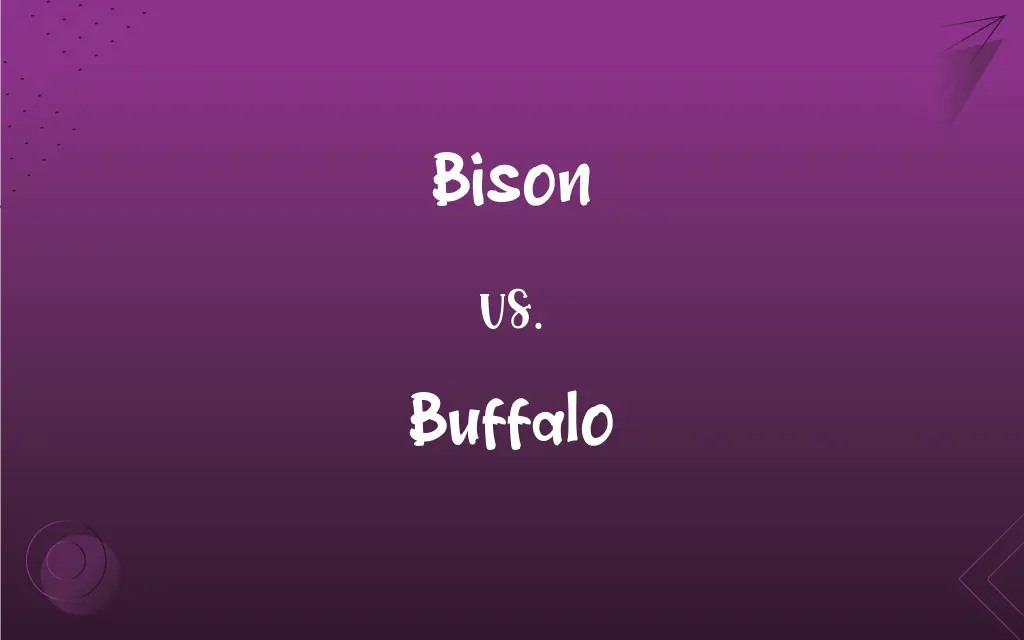Bison vs. Buffalo: What's the Difference?
Edited by Janet White || By Harlon Moss || Updated on October 6, 2023
Bison are large, shaggy-haired mammals native to North America and Europe; buffalo are native to Africa and Asia with smoother coats.

Key Differences
Bison and buffalo are both large herbivorous mammals, but they belong to different parts of the world and have distinct characteristics. Bison, often recognized by their massive size, hump at their shoulders, and shaggy dark brown fur, are primarily found in North America (e.g., American bison) and parts of Europe (e.g., European bison or wisent).
Buffalo, on the other hand, can be split into two primary species: the African buffalo and the Asian buffalo (or water buffalo). The African buffalo, or Cape buffalo, has large, curved horns and is found, as the name suggests, in Africa. The Asian buffalo, with its sweeping crescent horns and semi-aquatic nature, is native to the Asian continent.
While Bison have a thick, shaggy coat particularly adapted to the cold environments of the plains and forests, buffalo have a relatively smoother coat. The differences between bison and buffalo go beyond their appearances. For instance, while both animals play vital roles in their ecosystems, bison have been a symbol of the American West, and buffalo, especially the water buffalo, hold significant agricultural importance in many Asian countries.
It's common for people to use "buffalo" colloquially in the U.S. when referring to bison, especially in historical contexts like the "buffalo nickel" or "buffalo soldiers." However, scientifically speaking, bison and buffalo are distinct animals with different evolutionary histories and characteristics.
Comparison Chart
Native Region
North America and Europe
Africa and Asia
ADVERTISEMENT
Coat
Thick, shaggy, and dark brown
Smoother and can vary from dark brown to gray
Horns
Short and sharp
Large, curved (African); Sweeping crescent (Asian)
Notable Species
American Bison, European Bison (Wisent)
African Buffalo, Asian Buffalo (Water Buffalo)
Role in Ecosystem
Symbolic in American West; Grazers in plains and forests
Agricultural importance, especially in Asia
Bison and Buffalo Definitions
Bison
A shaggy-haired mammal of North America and Europe.
The bison roamed the plains in vast numbers.
ADVERTISEMENT
Buffalo
Herbivore known for its large curved horns.
The horns of the African buffalo are impressive and often used in battles with rivals.
Bison
Large herbivore with a characteristic shoulder hump.
The hump on the bison helps it plow through snow.
Buffalo
The Asian species often assists with agricultural tasks.
The water buffalo is commonly used for plowing rice fields in Asia.
Bison
A ruminant known for its shaggy mane and beard.
The bison's beard is more pronounced in males than in females.
Buffalo
Distinct from bison, despite colloquial confusions.
While often mistakenly called buffalo, the American bison is a different species.
Bison
The largest terrestrial mammal in North America.
Bison are known for their impressive size and strength.
Buffalo
Large mammal native to Africa and Asia.
The buffalo is revered in many cultures for its strength.
Bison
A symbol of the American West.
Bison have made a significant comeback after near extinction.
Buffalo
A significant source of dairy in some cultures.
Buffalo milk is richer and thicker than cow's milk.
Bison
A bovine mammal (Bison bison) of western North America, having large forequarters, a shaggy mane, and a massive head with short curved horns; a buffalo.
Buffalo
Any of several large African and Asian ruminant mammals of the family Bovidae, such as the water buffalo and the African buffalo.
Bison
A bovine mammal (Bison bonasus) of Europe, similar to the American bison but with a somewhat smaller head and longer horns; a wisent.
Buffalo
The American bison (Bison bison).
Bison
The flesh of the American bison, used as food.
Buffalo
The flesh of the American bison, used as food.
FAQs
Are bison only found in America?
No, there's also the European bison or wisent found in parts of Europe.
Were bison nearly extinct at some point?
Yes, bison populations were decimated in the 19th century but have since rebounded due to conservation efforts.
bison or buffalo?
Both can be quite large, but bison, especially males, can weigh more than the average buffalo.
Are buffalo used in agriculture?
Yes, particularly the Asian water buffalo, which is essential for plowing and other tasks.
Is the American buffalo the same as the bison?
No, what's colloquially called the "American buffalo" is actually the American bison.
Are bison and buffalo used for meat?
Yes, both bison and buffalo meat are consumed in various parts of the world. Bison meat is leaner and is often considered a healthier red meat option.
How fast can a bison run?
Despite their size, bison are agile and can run at speeds up to 35 mph (56 km/h).
Are there any white buffalo?
"White buffalo" refers to bison with a rare genetic condition causing white fur, considered sacred by some Native American tribes.
Do buffalo produce milk for consumption?
Yes, especially the Asian buffalo; its milk is used to make dairy products like mozzarella.
Can buffalo swim?
Yes, particularly the Asian water buffalo, which is known to be semi-aquatic and can swim well.
How long do bison and buffalo live?
Typically, bison can live up to 15-20 years in the wild, while buffalo can live between 20-25 years.
Are there any cultural or religious significances attached to buffalo or bison in certain societies?
Yes, for instance, the American bison holds spiritual significance for many Native American tribes, and in Asia, the water buffalo has religious importance in festivals and folklore.
Do buffalo and bison have the same diet?
Both are herbivores, primarily grazing on grasses, but the specifics of their diet can vary based on habitat.
How can I differentiate between a bison and a buffalo based on appearance?
Look for a hump and shaggy fur for bison. Buffalo have larger horns and smoother coats.
Is "buffalo" a general term for large bovine animals?
No, buffalo specifically refers to species in Africa and Asia. It's a common misconception to label bison as buffalo in America.
Are bison dangerous to humans?
While bison are generally peaceful, they are wild animals and can be unpredictable. Approaching them, especially during the mating season or near calves, can be dangerous.
Do buffalo have predators in the wild?
Yes, especially the young and weak ones. Lions, hyenas, and crocodiles are known predators of the African buffalo.
Are there any conservation efforts for bison and buffalo?
Yes, while bison have seen successful conservation efforts in North America, some buffalo subspecies, like the wild water buffalo, are endangered and have conservation programs in place.
Is it true that a buffalo's horn base can be used to determine its age?
While not precise, the horn base's size in African buffalo can give a general idea about its age.
Do bison and buffalo live in groups?
Yes, both bison and buffalo are social animals and tend to live in herds.
About Author
Written by
Harlon MossHarlon is a seasoned quality moderator and accomplished content writer for Difference Wiki. An alumnus of the prestigious University of California, he earned his degree in Computer Science. Leveraging his academic background, Harlon brings a meticulous and informed perspective to his work, ensuring content accuracy and excellence.
Edited by
Janet WhiteJanet White has been an esteemed writer and blogger for Difference Wiki. Holding a Master's degree in Science and Medical Journalism from the prestigious Boston University, she has consistently demonstrated her expertise and passion for her field. When she's not immersed in her work, Janet relishes her time exercising, delving into a good book, and cherishing moments with friends and family.







































































